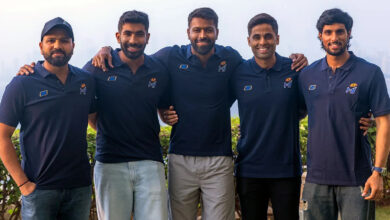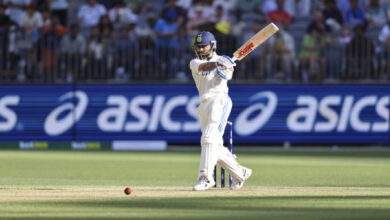Time to pull the plug on Kohli’s T20I career

In the last couple of weeks, Virat Kohli the batsman has had the demeanour of a Netflix murderer living in constant expectation of his victim’s body being found. Such has been his nervy presence in the middle. It’s the expressions after his dismissals that have been even more telling: the rueful smile of a man who feels the world has conspired to go topsy-turvy on him that turns into an anguished look at the heavens at some point in his trudge back to the dug-out. A look of a man who seemingly feels he has been cooked, done in, and trapped a fateful turn of events.
Even if he scores a brace of fifties from here on, the time has come for the national selectors to contemplate a halt on Kohli’s T20I career. Going his recent decisions on captaincy, it won’t be a surprise if he himself pulls the plug on this format after the IPL, but in case he doesn’t, the selectors would do well to take that call. Former head coach Ravi Shastri, a mentor he trusts, has already said that Kohli needs a break for sure to prolong his career, and the selectors will do well to read between the lines.
On Tuesday, against Trent Boult in particular, he could have got out at least three times before he was eventually dismissed. A hesitant poke that almost carried straight to short square-leg, two iffy cuts to not-so-short deliveries that nearly ricocheted on to his stumps and if one thought it was the luck he needed, he went too early into his pull shot against Prasidh Krishna and toe-ended a catch to point. On the positive side, he wasn’t late on that shot – that would have made one doubt his reflexes – but that’s a mere consolation.
Kohli is in a fascinating position himself. Once, in his pomp, in a podcast with commentator Mark Nicholas, he spoke about how he views batting. “I see batting as 70 percent technical. I know a lot of people say 80 percent mental; in a preparation point of view, yes. But I believe… if your foundations aren’t strong, you can’t be mentally strong as you will have doubts about your own game. And you are fighting with yourself first rather than thinking of what I can do here.” The usual cricketers’ cliché is about how it’s 90 percent mental, but Kohli sees it differently.
That puts him in an interesting space right now. A cocktail of mental and technical stuff has had him reeling for a while now, not just this IPL but prior to that as well, and self-doubts creep into the best of the best. Add to it, so many eventful episodes have occurred in the not-so-dant past – from his tiffs with the BCCI over resignations and what not – no wonder Kohli has been wearing that look of self-pity-tinged ruefulness.
Even an in-form Kohli doesn’t fit India’s T20 plans
The fact that Kohli opened in the game against Rajasthan Royals might be good for Royal Challengers Bangalore in the coming days if he succeeds, but India certainly doesn’t need Kohli the opener.
The assessment has nothing to do with his recent failures this season (though that has only exacerbated it, of course) but even otherwise he isn’t the best fit in India’s T20 team for the World Cup. There is a sameness in the top order that needs a more adventurous No.3 batsman. Even at his best, Kohli’s T20 blueprint is a touch anachronic which still can be valuable in some other team; not India, though. A Kane Williamson figure for New Zealand, where he can anchor, move around the middle overs, before turning on the heat in the end. It’s fair to say that it’s unlikely that any IPL franchise would bunch Rohit, Kohli, and KL Rahul together at the top; it’s time India also doesn’t. To fit in Kohli, India would have to make concessions elsewhere which aren’t optimum in terms of value to the team.
When he started this IPL, the question was about how much more can he extend his T20 game to fit into the Indian team’s requirements. It was clear that he had to press the accelerator pretty early in his piece, take the lead in striking, and not just drag it to the end overs. With players like Suryakumar Yadav, Hardik Pandya, Rishabh Pant, Shreyas Iyer (though he has considerably slipped up this season) and Dinesh Karthik, India need a proactive No.3. For that, Kohli had to extend his T20 game and do something he hasn’t always done before. At least consently.
And going the words of RCB batting coach Sanjay Bangar, it seemed that was the plan. Bangar talked about how Kohli wanted to press on more against the spinners in particular but instead, he has slipped into a hole of poor scores. That has caused its own spill-over effects but the point is even if he had carried on his regular T20 style of play from the past, he shouldn’t be cutting a place in the Indian T20 team.
What have been his usual strengths have been a bit of a downside in T20. It’s one format where he hasn’t really changed his game. It has worked like a treat for him in his cricket in general, but time has come in T20, as witnessed in the last T20 World Cup from other successful teams, for him to get a move on.
Before this recent slip-up of form, it has been generally assumed that Kohli can if he wishes; just that the way he reads the game, especially with hitters like AB de Villiers in the team, wasn’t needed. However, that assumption isn’t an accurate reading of his game. It’s just how he plays. He chose not to expand his shots repertoire, he chose not to go for any extravagant shots, he chose not to press the accelerator early, not because of other personnel in the team, but the contention here is that’s his game.
Anachronic approach
With the great confidence in his heyday, he has personified that white-ball principle of “I can make up later in the innings”. It’s a nice theory on paper but as we have seen even with RCB in the past, it doesn’t quite hold up.
That reticence can be a choice and situational but when it becomes the default mode, it’s time for reflection. Going Bangar’s comments and some of his shot selections in this IPL, it seems Kohli was keen to change that, to have one last throw of the dice in this format but unluckily for him, it hasn’t quite worked out.
Is it a coincidence that the form of Kohli, Rohit and Ravindra Jadeja have nosedived since the recent captaincy changes. Kohli lost his captaincy everywhere, Sharma acquired the captaincy in all formats, and Jadeja was thrust into a new role. Twitter and memes have been filled with various versions of this argument. It’s a mine-field to enter really, as it can be twed to fit individual biases.
A bit of Sharma’s form can be linked with the woefulness of his opening partner Ishan Kishan. Sharma’s best in T20 comes when he doesn’t have to worry about an early surge of runs or the drought from the other end. Great batsmen, of course, need to go beyond that handicap but Sharma’s T20 batting has been like that for a while now. Just like Kohli’s, set in his own ways.
It’s clear that both have tried this season. Sharma has tried to soak up Kishan’s bad form and tried to set the tempo on his own, but has succumbed. Kohli has tried to up the ante from the start but hasn’t managed.
Against Umesh Yadav, knowing well the bounce on the pitch and the bowler’s plan, he went for a forceful on-the-up punch and fell. Against Dushmantha Chameera, on a pitch with steep tennis- ball bounce, he went for a semi-vertical punch-drive that he plays square of the pitch, trusting his wrs to ride the bounce. Aggressive intent but wrong shot, wrong time (it was his first ball), wrong pitch. Then there are two run-outs where the former India player and IPL coach Mohammad Kaif was so surprised that he was moved to comment on air why Kohli didn’t dive. Kaif’s words suggested that the Kohli of the past, the one with a clear head, would have shown the nous and the instinct to immediately dive back into the crease, instead of just trying to slide his bat and finding himself an inch or two short of safety. Then there were two leg-side heaves off length deliveries that found the men in the deep without really threatening the boundary. It’s a shot of a man wanting to show intent but without the touch or form to pull it off, and also against the instinct of a normally more conservative T20 batsman.
One hopes that Kohli regains touch for himself, for RCB, and for his fans, but it’s time India looks at the bigger picture – which can only help Kohli the Test and ODI batsman – and call time on his T20 career.







